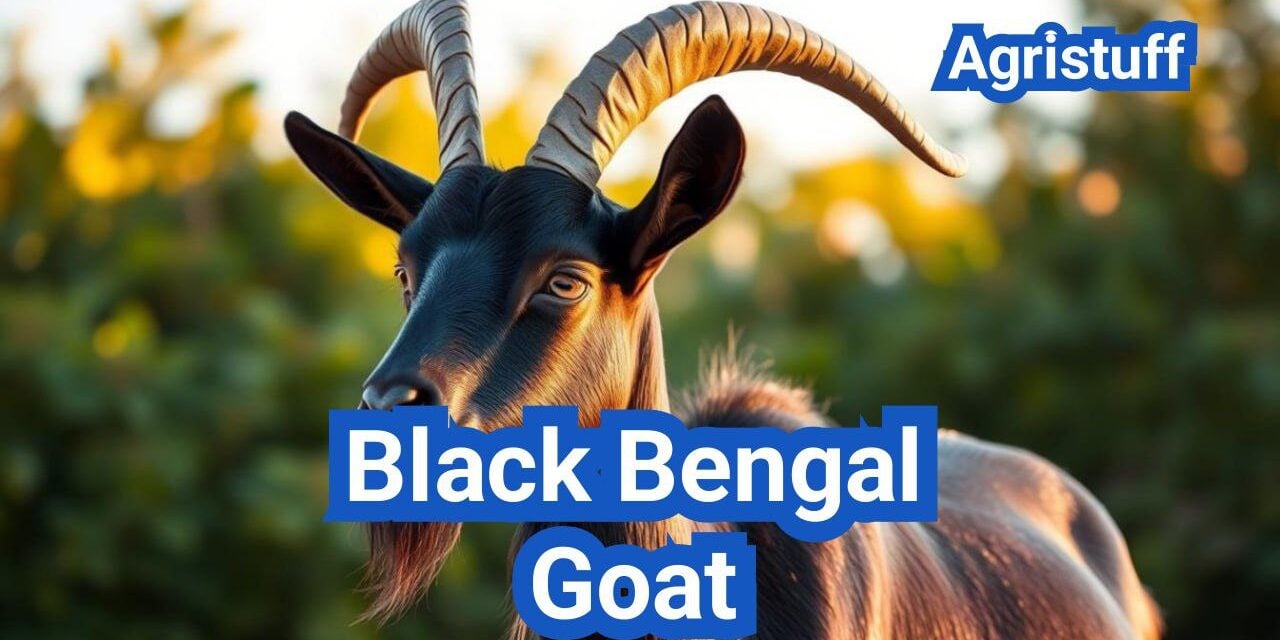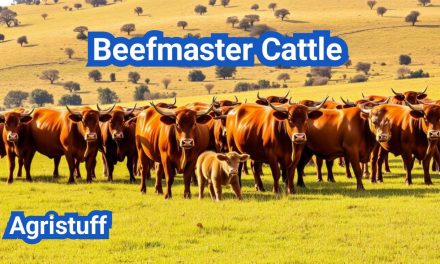The Black Bengal Goat is a significant breed in Bangladesh and eastern India, recognized for its adaptability and economic importance.
This breed is valued for providing meat, milk, and leather, making it a vital part of the local economy.
The history and origin of the Black Bengal Goat are closely tied to the region’s culture and agricultural practices.
Understanding the characteristics, breeding practices, and uses of this breed is essential for appreciating its value.
Key Takeaways
- The Black Bengal Goat is a crucial breed in Bangladesh and eastern India.
- It is known for its adaptability and economic significance.
- The breed provides meat, milk, and leather.
- Its history and origin are linked to regional culture and agriculture.
- Understanding its characteristics and breeding practices is vital.
Overview of the Black Bengal Goat
The Black Bengal goat is a highly valued breed in global agriculture due to its exceptional hardiness and adaptability. This breed has gained recognition not only for its robust characteristics but also for its significant economic importance in various regions. As a popular goat breed, it offers numerous benefits to farmers and contributes to local economies.
What Makes Black Bengal Goats Special
Black Bengal goats are known for their exceptional fertility and high kid survival rate, making them an attractive choice for breeders. Their ability to thrive in diverse environmental conditions adds to their appeal. Additionally, their compact size and agility make them easy to manage.
The breed’s efficient meat production capabilities are another significant factor in its popularity. Black Bengal goats are bred not only for their meat but also for their skin and milk, providing multiple income streams for farmers. Their adaptability to various farming systems, from small-scale to commercial operations, further enhances their value.
Economic Importance in Global Agriculture
The economic importance of Black Bengal goats in global agriculture cannot be overstated. They contribute significantly to the livelihoods of many farmers, particularly in rural areas where they are often the primary source of income. The breed’s ability to produce high-quality meat, milk, and skin products makes it a valuable asset.
In regions where they are bred, Black Bengal goats play a crucial role in local economies. They provide employment opportunities and contribute to the GDP through their various products. Moreover, their manure is used as fertilizer, adding to their overall economic benefits.
History and Origin of Black Bengal Goat

The Black Bengal goat has a rich history that spans centuries, originating in the regions of Bangladesh and West Bengal. This breed has been an integral part of the agricultural landscape in these areas, known for its adaptability and productivity.
Geographic Origin in Bangladesh and West Bengal
The Black Bengal goat is native to the lush and fertile regions of Bangladesh and the Indian state of West Bengal. The climate and geography of these areas have played a significant role in shaping the characteristics of this breed.
The region’s rich biodiversity, coupled with traditional farming practices, has contributed to the breed’s development over time. The Black Bengal goat thrives in the local environment, demonstrating a remarkable ability to adapt to the climatic conditions of the region.
Historical Development and Breed Evolution
The historical development of the Black Bengal goat is closely tied to the agricultural traditions of Bangladesh and West Bengal. Over centuries, farmers in these regions have selectively bred goats to enhance desirable traits such as fertility, meat quality, and disease resistance.
This selective breeding has resulted in a breed that is not only well-suited to the local environment but also highly productive. The evolution of the Black Bengal goat is a testament to the ingenuity of local farmers and their deep understanding of animal husbandry.
The breed’s evolution can be summarized in the following key factors:
- Selective breeding for desirable traits
- Adaptation to local climatic conditions
- Development of resistance to local diseases
| Characteristics | Description |
|---|---|
| Geographic Origin | Bangladesh and West Bengal |
| Primary Use | Meat Production |
| Breed Traits | High fertility, disease resistance |
The Black Bengal goat’s history and origin are deeply rooted in the cultural and agricultural heritage of its native regions. Understanding its development provides valuable insights into its significance and potential for future farming practices.
Physical Characteristics of Black Bengal Goat
The Black Bengal goat is renowned for its unique physical attributes, making it a valuable asset in various agricultural contexts. Its compact size, varied coat colors, and distinctive features contribute to its popularity among farmers and breeders.
Size and Appearance
The Black Bengal goat is characterized by its relatively small size, typically weighing between 20-30 kg. This compact body size makes it an ideal choice for small-scale farming operations. The breed’s appearance is also notable for its robust build and well-proportioned body.
Coat and Color Variations
One of the distinguishing features of the Black Bengal goat is its varied coat color. While the name suggests a predominantly black coat, these goats can also be found in brown and gray. The coat is usually short and smooth, requiring minimal grooming.
The color variations are not just aesthetically pleasing; they also contribute to the breed’s adaptability to different environmental conditions. The genetic diversity reflected in their coat colors is a significant advantage in breeding programs.
Distinctive Features and Breed Standards
The Black Bengal goat has several distinctive features that adhere to breed standards. These include a compact body, a short, sturdy neck, and well-developed udders in females. The breed is also known for its black skin, which is highly valued for its quality.
Breed standards also emphasize the importance of a well-proportioned head, with a straight or slightly convex profile, and a pair of expressive eyes. The overall appearance should convey a sense of robustness and health, indicative of the breed’s hardiness and productivity.
By adhering to these breed standards, breeders can ensure that their Black Bengal goats retain the characteristics that make them so valuable. This includes not just their physical attributes but also their productivity and adaptability.
Temperament and Behavior

With their calm demeanor and high intelligence, Black Bengal goats are not only easy to handle but also thrive in diverse environments. This unique combination of temperament and behavior makes them an attractive choice for farmers worldwide.
Natural Disposition and Intelligence
Black Bengal goats are known for their docile nature, which is a significant factor in their popularity among goat breeders. Their intelligence is another key characteristic that facilitates their adaptability to various farming systems.
The intelligence of Black Bengal goats allows them to navigate complex environments and respond well to training, making them a versatile breed for different agricultural purposes.
Adaptability to Different Environments
One of the standout features of the Black Bengal goat is its adaptability to different climates and farming conditions. This hardy breed can thrive in a variety of settings, from intensive farming systems to more extensive, free-range environments.
Their ability to adapt is largely due to their robust temperament and intelligence, allowing them to adjust to new surroundings and management practices with ease.
Black Bengal Goat Breeding
Effective Black Bengal Goat Breeding requires a thorough understanding of their reproductive cycle and breeding season. The breeding season for Black Bengal goats typically occurs during the cooler months, with a gestation period of about 145-150 days.
Reproductive Cycle and Breeding Season
The reproductive cycle of Black Bengal goats is an essential factor in their breeding. Does typically come into heat every 18-21 days, and the breeding season can vary depending on geographical location and environmental conditions.
Breeding Season: The ideal breeding season for Black Bengal goats is during the cooler months, allowing for kidding during the spring when forage is more abundant.
Breeding Techniques and Selection Criteria
Successful Black Bengal Goat Breeding involves careful selection of breeding stock based on factors such as genetic diversity, growth rate, and fertility.
- Selection of does and bucks based on breed standards and genetic diversity.
- Implementation of a breeding program that includes record-keeping and selection criteria.
Breeding Techniques: Farmers may use natural breeding or assisted reproductive technologies like artificial insemination to improve breeding efficiency.
Kidding and Postpartum Care
Kidding is a critical phase in the Black Bengal Goat Breeding cycle. Proper care during this period is essential for the health of both the doe and the kids.
Postpartum Care: Ensuring the doe receives adequate nutrition and healthcare postpartum is crucial for her recovery and the health of the kids.
Monitoring the kids’ health and providing appropriate vaccinations and care is vital for their survival and growth.
Growth and Development Stages

Understanding the growth stages of Black Bengal goats is crucial for farmers to optimize their care and nutrition. Black Bengal goats are known for their rapid growth, particularly in the first few months of life.
Weight at Different Ages
The weight of Black Bengal goats varies significantly at different stages of their development. Typically, kids are born with a weight ranging from 1.5 to 2.5 kg. By the age of 6 months, they can weigh between 15 to 20 kg, and by 24 months, they can reach weights of 25 to 35 kg or more, depending on factors such as nutrition, genetics, and overall health.
Here’s a general overview of the weight ranges for Black Bengal goats at different ages:
- At birth: 1.5 to 2.5 kg
- At 3 months: 8 to 12 kg
- At 6 months: 15 to 20 kg
- At 12 months: 20 to 25 kg
- At 24 months: 25 to 35 kg
Growth Rate Factors and Optimization
Several factors influence the growth rate of Black Bengal goats, including genetics, nutrition, health care, and management practices. Ensuring that goats receive adequate nutrition, including high-quality feed and clean water, is essential for optimal growth.
Nutritional Factors: Providing a balanced diet that includes essential minerals and vitamins is crucial. Supplements can be used to enhance growth rates, especially during critical growth periods.
Health Care: Regular veterinary check-ups and vaccinations can prevent diseases that might affect growth. Parasite control is also vital to ensure that goats are not stressed by internal parasites.
Optimizing growth rates involves a combination of good nutrition, proper health care, and effective management practices. Farmers should monitor the growth of their goats regularly to identify any issues early and make necessary adjustments.
“Proper nutrition and health care are the cornerstones of achieving optimal growth rates in Black Bengal goats.”
By focusing on these aspects, farmers can improve the overall productivity and health of their Black Bengal goat herds.
Step-by-Step Black Bengal Goat Farming Guide

The journey to establishing a profitable Black Bengal Goat farm involves several crucial steps. Successful Black Bengal goat farming requires careful planning, selection of healthy breeding stock, appropriate housing, and effective management systems.
Step 1: Planning Your Farm Setup
Planning is the foundation of any successful farming venture. For Black Bengal Goat farming, this involves determining the scale of your operation, understanding local regulations, and assessing market demand. It’s essential to create a comprehensive business plan that outlines your goals, production costs, and marketing strategies.
Step 2: Selecting Healthy Breeding Stock
The quality of your breeding stock directly impacts the productivity and profitability of your farm. When selecting Black Bengal Goats, look for animals with good health, robust physical characteristics, and a history of high fertility. Genetic diversity is also crucial to prevent inbreeding and ensure the long-term viability of your herd.
Step 3: Creating Proper Housing and Shelter
Adequate housing is vital for protecting your goats from predators, harsh weather conditions, and diseases. The shelter should be well-ventilated, dry, and spacious enough to accommodate your herd comfortably. Proper fencing is also necessary to prevent escape and predator entry.
Step 4: Implementing Management Systems
Effective management systems are critical for the day-to-day operations of your farm. This includes implementing a feeding schedule, health monitoring, and breeding programs. Record-keeping is essential for tracking the performance of your herd and making informed decisions.
As one expert notes,
“The key to successful goat farming lies in attention to detail and a willingness to adapt to changing circumstances.”
By following these steps and maintaining a commitment to quality and animal welfare, you can establish a thriving Black Bengal Goat farm.
Feed and Nutrition Management

Nutrition plays a vital role in the overall well-being and productivity of Black Bengal goats. A well-balanced diet is essential for maintaining their health, ensuring high-quality products, and maximizing profitability for farmers.
Basic Nutritional Requirements
Black Bengal goats require a diet rich in nutrients, including proteins, carbohydrates, fats, vitamins, and minerals. High-quality forage is fundamental to their nutritional needs, providing essential fiber and other nutrients.
The nutritional requirements vary depending on factors such as age, sex, and production stage. For instance, lactating does have higher nutritional needs compared to dry does or bucks.
Feeding Schedule and Quantity Guidelines
A well-planned feeding schedule is crucial for the health and productivity of Black Bengal goats. The quantity and quality of feed should be adjusted according to the goat’s age, size, and production level.
- Kids require a diet rich in protein and energy to support their growth and development.
- Lactating does need additional nutrients to support milk production.
- Adult goats require a balanced diet to maintain their weight and overall health.
Essential Minerals and Supplements
Minerals and supplements play a critical role in the diet of Black Bengal goats, ensuring they receive all necessary nutrients for optimal health. Common supplements include calcium, phosphorus, and vitamins A, D, and E.
| Mineral/Supplement | Function |
|---|---|
| Calcium | Essential for bone development |
| Phosphorus | Important for bone health and energy production |
| Vitamin A | Critical for vision, immune function, and skin health |
By understanding and implementing proper feed and nutrition management, farmers can improve the health and productivity of their Black Bengal goats, leading to better outcomes and increased profitability.
Health Management and Common Diseases

Health management plays a vital role in the overall success of Black Bengal goat farming. Effective health management involves a combination of preventive healthcare practices, timely diagnosis, and appropriate treatment protocols to maintain the well-being of the goats.
Preventive Healthcare Practices
Preventive healthcare is the cornerstone of maintaining a healthy Black Bengal goat herd. This includes regular vaccinations, parasite control measures, and nutritional management. Regular vaccinations help protect against common diseases, while parasite control measures prevent infestations that can lead to significant health issues.
As noted by experts, “A well-planned preventive healthcare program is essential for reducing the risk of diseases in Black Bengal goats.”
“Regular health checks and maintaining a clean environment are critical components of a successful health management strategy.”
Common Diseases in Black Bengal Goats
Black Bengal goats are susceptible to various diseases, including parasitic infections and respiratory issues. Common diseases include parasitic gastroenteritis, pneumonia, and caseous lymphadenitis. Understanding the symptoms and causes of these diseases is crucial for effective management.
- Parasitic gastroenteritis: Caused by internal parasites, leading to weight loss and diarrhea.
- Pneumonia: A respiratory infection that can be caused by bacteria, viruses, or fungi.
- Caseous lymphadenitis: A bacterial infection that affects the lymph nodes.
Treatment Protocols and Management
Effective treatment protocols involve accurate diagnosis followed by appropriate treatment. For parasitic infections, anthelmintic drugs are used, while antibiotics are employed for bacterial infections. Management practices, such as isolating infected animals and improving hygiene, are also crucial.
A comprehensive treatment plan should be developed in consultation with a veterinarian to ensure the best outcomes for the herd.
Uses and Products of Black Bengal Goat

The Black Bengal goat is a versatile breed, valued for its meat, milk, and skin. This breed has been a cornerstone in many agricultural economies, providing a range of products that are highly sought after.
Meat Production and Quality
Black Bengal goats are renowned for their high-quality meat, which is tender and flavorful. The meat is considered a delicacy in many cultures and is often preferred for its tenderness and taste. Meat production from Black Bengal goats is a significant aspect of their economic value, with many farmers raising them specifically for this purpose.
- High-quality meat with tender texture
- Preferred for its flavor and nutritional value
- Significant contributor to local meat markets
Milk Production Characteristics
In addition to meat, Black Bengal goats are also valued for their milk production. While not as high as some other dairy breeds, their milk is rich in nutrients and is used to produce a variety of dairy products. Milk production from these goats is an important secondary income source for many farmers.
- Milk is rich in nutrients and used for dairy products
- Provides an additional income stream for farmers
- Contributes to local dairy industries
Skin and Leather Quality and Applications
The skin of Black Bengal goats is highly prized for its quality and is used to produce high-grade leather. The leather made from their skin is durable, flexible, and highly valued in the leather industry. This aspect of the breed’s utility adds to its overall economic importance.
- High-quality skin used for leather production
- Leather is durable and highly valued
- Contributes significantly to the leather industry
Economic Analysis of Black Bengal Goat Farming
Economic analysis plays a pivotal role in assessing the profitability of Black Bengal goat farming ventures. This analysis is crucial for farmers and investors to understand the financial implications of their decisions.
Initial Investment Requirements
The initial investment for Black Bengal goat farming includes costs associated with purchasing breeding stock, infrastructure, and initial operational expenses. The cost of breeding stock can vary significantly based on factors such as the quality and genetic lineage of the goats.
Infrastructure costs include setting up appropriate housing and fencing for the goats. The quality of infrastructure can impact the overall health and productivity of the goats, thereby affecting the farm’s profitability.
Operational Costs Breakdown
Operational costs for Black Bengal goat farming include feed, veterinary care, and labor. Feed costs are typically the largest recurring expense, as goats require a balanced diet to maintain their health and productivity.
Veterinary care is another significant cost, as regular health checks and vaccinations are essential to prevent diseases. Labor costs also contribute to the overall operational expenses, especially as the farm scales up.
Potential Returns and Profit Margins
The potential returns from Black Bengal goat farming come from the sale of goats for meat, milk, or breeding purposes. The profit margins can be substantial if the farm is managed efficiently, with careful attention to breeding, nutrition, and health management.
The price of Black Bengal goats can fluctuate based on market demand and supply. Understanding the Black Bengal goat price trends is crucial for farmers to maximize their returns.
In conclusion, a thorough economic analysis is essential for the success of Black Bengal goat farming. By understanding the initial investment, operational costs, and potential returns, farmers can make informed decisions to optimize their farm’s profitability.
Black Bengal Goat in the United States

With its hardiness and versatility, the Black Bengal goat is gaining traction among American farmers. The breed’s adaptability to various climates and management systems makes it an attractive option for farmers across the United States.
Availability and Adoption in American Farms
The Black Bengal goat is becoming increasingly popular in American farms due to its high productivity and resilience. Farmers are adopting this breed for its ability to thrive in different environments.
- Key factors driving adoption:
- Hardiness and adaptability
- High productivity
- Economic benefits
As more farmers learn about the benefits of raising Black Bengal goats, the demand for this breed is expected to grow. Currently, several farms across the US are breeding Black Bengal goats, contributing to their increasing availability.
Adaptability to US Climate and Conditions
One of the significant advantages of the Black Bengal goat is its ability to adapt to different climates and farming conditions. This breed can thrive in various environments, making it suitable for farmers in different regions of the United States.
“The Black Bengal goat’s adaptability is one of its most significant advantages, allowing it to flourish in diverse climates and management systems.”
The breed’s hardiness and productivity make it an excellent choice for American farmers looking to diversify their livestock. With proper care and management, Black Bengal goats can be a valuable addition to farms across the US.
Black Bengal Goat Price Guide

Black Bengal goat prices are influenced by a multitude of factors including age, health, and breed quality. Understanding these factors is crucial for both buyers and sellers in the market.
Factors Affecting Market Price
The market price of Black Bengal goats can be affected by several key factors. These include:
- Age: The age of the goat can significantly impact its price. Younger goats with a higher potential for breeding or meat production are generally more valuable.
- Health: Goats that are healthier and have a stronger genetic makeup command higher prices due to their potential for better productivity.
- Breed Quality: The purity and quality of the breed are crucial. High-quality Black Bengal goats with desirable traits are more expensive.
- Regional Demand: The demand for Black Bengal goats varies by region, affecting their market price. Areas with a high demand for goat meat or breeding stock tend to have higher prices.
Average Market Prices in Different Regions
The average market price for Black Bengal goats can vary significantly across different regions. The following table provides a general overview of the price ranges in various areas:
| Region | Average Price per Goat |
|---|---|
| Bangladesh | $50-$100 |
| India (West Bengal) | $60-$120 |
| United States | $150-$300 |
These prices are subject to change based on the factors mentioned earlier. It’s essential for buyers and sellers to stay informed about the current market conditions to make the best decisions.
Advantages of Raising Black Bengal Goats
Farmers can reap multiple benefits from raising Black Bengal goats, from low initial investment to high reproductive rates. This breed is particularly advantageous for both small-scale farmers and those engaged in commercial production.
Benefits for Small-Scale Farmers
For small-scale farmers, Black Bengal goats offer a viable means of diversifying their agricultural operations. The low initial investment required to start a Black Bengal goat farm makes it accessible to farmers with limited capital. Additionally, the breed’s high reproductive rate ensures a quick return on investment.
The adaptability of Black Bengal goats to various environments is another significant benefit. They can thrive in different climatic conditions, making them suitable for farming in diverse geographical locations.
Key benefits for small-scale farmers include:
- Low initial investment
- High reproductive rate
- Adaptability to different environments
Advantages for Commercial Production
For commercial producers, Black Bengal goats offer the potential for significant returns through the sale of meat, milk, and hides. Their prolific breeding ensures a consistent supply of products, helping to meet market demands.
The quality of products derived from Black Bengal goats, such as their meat and leather, is highly valued. This can command a premium price in the market, further enhancing the profitability of commercial Black Bengal goat farming operations.
The advantages of commercial production include:
- Potential for significant returns on investment
- Consistent supply of products due to prolific breeding
- High-quality products that command premium prices
In conclusion, raising Black Bengal goats offers numerous advantages for both small-scale farmers and commercial producers. Their hardiness, productivity, and the high quality of their products make them an attractive choice for farmers looking to diversify or expand their agricultural operations.
Challenges and Solutions in Black Bengal Goat Farming
Despite its numerous benefits, Black Bengal goat farming is not without its challenges. Farmers and producers often face a range of obstacles that can impact the productivity and profitability of their operations.
Common Obstacles and Limitations
Black Bengal goat farming is associated with several challenges, including:
- Disease management: Goats are susceptible to various diseases, which can significantly affect their health and productivity.
- Nutritional deficiencies: Providing adequate nutrition is crucial for the health and growth of Black Bengal goats.
- Market fluctuations: The demand and supply of goat products can fluctuate, affecting prices and profitability.
- Environmental factors: Climate change, inadequate shelter, and poor waste management can also pose challenges.
Practical Solutions and Mitigation Strategies
To overcome these challenges, farmers can implement several practical solutions:
- Disease Management: Implement regular health checks, vaccinations, and maintain a clean environment to prevent disease outbreaks.
- Nutritional Management: Provide a balanced diet that includes essential nutrients, and consider consulting with a veterinarian or nutritionist to optimize feeding strategies.
- Market Analysis: Stay informed about market trends and adjust production accordingly to maximize profitability.
- Environmental Adaptation: Invest in appropriate shelter and waste management systems to mitigate the impact of environmental factors.
By understanding the challenges associated with Black Bengal goat farming and implementing these practical solutions, farmers can improve the sustainability and profitability of their operations.
At The End of: Black Bengal Goat
The Black Bengal goat is a valuable breed with significant economic and agricultural importance. Its hardiness, productivity, and adaptability make it an attractive choice for farmers worldwide. Throughout this article, we have explored the history, characteristics, breeding, and uses of the Black Bengal goat, highlighting its potential for meat, milk, and skin production.
As a breed, the Black Bengal goat offers numerous benefits for farmers, from its high reproductive rate to its resistance to diseases. Its adaptability to different environments and management systems makes it an ideal choice for both small-scale and commercial farming operations.
In conclusion, the Black Bengal goat is a versatile and productive breed that can contribute significantly to the agricultural economy. By understanding its characteristics, breeding, and management requirements, farmers can harness the full potential of this valuable breed.
FAQ
What is the origin of the Black Bengal Goat breed?
The Black Bengal Goat breed originates from Bangladesh and West Bengal, India, where it has been raised for centuries for its meat, milk, and hide.
What are the distinctive physical characteristics of Black Bengal Goats?
Black Bengal Goats are known for their compact size, black coat color, and distinctive horns. They have a sturdy build and are well adapted to the hot and humid climates of their native regions.
What is the temperament of Black Bengal Goats like?
Black Bengal Goats are known for their friendly and docile nature, making them a good choice for small-scale farmers and those new to goat farming.
How are Black Bengal Goats bred and managed for reproduction?
Black Bengal Goats are bred using traditional methods, with a focus on selecting animals with desirable traits such as fertility, growth rate, and disease resistance. Breeding is typically done in a controlled manner to ensure optimal reproductive outcomes.
What are the growth and development stages of Black Bengal Goats?
Black Bengal Goats grow relatively quickly, with kids reaching maturity at around 6-12 months of age. Proper nutrition and care are essential to support optimal growth and development.
What are the nutritional requirements of Black Bengal Goats?
Black Bengal Goats require a balanced diet that includes high-quality forage, grains, and minerals. They have specific nutritional needs that must be met to ensure optimal health and productivity.
What are some common health issues in Black Bengal Goats?
Black Bengal Goats are susceptible to various health issues, including parasites, respiratory diseases, and reproductive problems. Regular veterinary care and preventive measures are essential to maintaining their health.
What are the uses and products of Black Bengal Goats?
Black Bengal Goats are raised for their meat, milk, and hide. Their meat is considered a delicacy in many cultures, and their milk is used to produce cheese, butter, and other dairy products.
Is Black Bengal Goat farming profitable?
Black Bengal Goat farming can be a profitable venture, especially for small-scale farmers. The breed’s high reproductive rate, fast growth rate, and adaptability to different environments make it an attractive option for many farmers.
Are Black Bengal Goats suitable for small-scale farming in the United States?
Yes, Black Bengal Goats can be suitable for small-scale farming in the United States, provided that farmers are aware of the breed’s specific needs and requirements. Climate, nutrition, and health management are key factors to consider.
How much do Black Bengal Goats cost?
The cost of Black Bengal Goats varies depending on factors such as age, quality, and location. On average, a healthy breeding doe can cost between $200-$500.
What are the advantages of raising Black Bengal Goats?
The advantages of raising Black Bengal Goats include their high reproductive rate, fast growth rate, and adaptability to different environments. They are also relatively low-maintenance and can thrive on a variety of diets.
Conclusion of: Black Bengal Goat
Introduction: Why the Black Bengal Goat Matters
The Black Bengal Goat is a small but highly productive meat goat breed that has drawn worldwide attention because of its exceptional fertility, quality meat, and valuable skin. For farmers in Bangladesh and eastern India, the Black Bengal Goat is often called the “poor man’s cow” because it turns crop residues, weeds, and kitchen scraps into cash income and high-quality protein.
Scientific reviews highlight that the Black Bengal Goat has been intensively studied for more than 50 years due to its economic importance, adaptability, and strong performance under low-input conditions. Performance of Black Bengal goat: a 50-year review
History and Origin of the Black Bengal Goat
The Black Bengal Goat is an indigenous goat breed that originated in the Bengal region, which today includes Bangladesh and the Indian state of West Bengal. Historical breeding work and population surveys show that Bangladesh has only one true native goat breed of its own, widely recognized as the Black Bengal Goat, and it represents the majority of the national goat population.
Studies from national research farms in Bangladesh report that more than 90% of goats in the country are Black Bengal Goat type, with the rest being Jamunapari or crossbreds, confirming the long-term dominance of this hardy genetic resource in the region. Morphometric characterization of Black Bengal Goat in Bangladesh
Distribution and Production Systems of Black Bengal Goat
Today, the Black Bengal Goat is concentrated in Bangladesh and neighboring parts of India, but interest in the breed is growing among researchers and smallholders in other countries because of its prolificacy and adaptability. Within Bangladesh, Black Bengal Goat flocks are typically kept in mixed crop–livestock systems, often under semi-scavenging or semi-intensive management where goats graze roadside vegetation and crop residues during the day and are housed at night.
Development reports on rural goat farming in Bangladesh repeatedly stress that the Black Bengal Goat plays a central role in smallholder livelihoods, particularly for landless or marginal farmers who rely on goats as a low-capital, fast-reproducing asset. Rural goat farming in Bangladesh: opportunities and challenges
Physical Characteristics and Breed Standards of Black Bengal Goat
The Black Bengal Goat is a dwarf-type goat with a compact body, fine bones, and a short glossy coat that is usually black, although brown, white, or piebald patterns also occur. Detailed morphometric studies conducted at Bangladesh Livestock Research Institute show that adult Black Bengal Goat does typically weigh around 15–20 kg, while bucks may reach 20–25 kg under farm conditions, with average body length around 46 cm and chest girth roughly 56 cm.
Horns are generally short to medium in length and both sexes are horned, while the ears are small and erect or semi-pendulous. These physical traits make the Black Bengal Goat easy to handle, transport, and house compared with larger meat breeds. Morphometric study of Black Bengal Goat under farming conditions
Growth, Reproduction, and Fertility of Black Bengal Goat
One of the most important reasons the Black Bengal Goat is so valuable is its strong reproductive performance relative to its body size.
Research on productive and reproductive traits shows that Black Bengal Goat females typically reach puberty early, have relatively short kidding intervals (often around 7–8 months under good management), and produce kids with acceptable growth rates for small-framed goats. Controlled farm studies report average kidding intervals around 188–200 days and service-per-conception rates a little above one, confirming that Black Bengal Goat does can produce kids reliably when nutrition and health are managed properly. Evaluation of productive and reproductive performance of Black Bengal goat
Litter Size, Kidding Interval, and Kid Survival in Black Bengal Goat
The Black Bengal Goat is especially famous for its high litter size and good kid survival, which together drive overall flock productivity. Numerous studies under both village and farm conditions show that Black Bengal Goat does often produce twins and triplets, with average litter sizes around 1.5–1.8 kids and occasional quadruplets.
Comparative work on Black Bengal Goat and crossbreds under semi-intensive management indicates that the breed combines high fecundity with reasonable kid survival, making it particularly efficient for small farms aiming to market more kids per doe each year. Research on litter size and reproductive performance in Black Bengal goats
Meat Quality and Carcass Traits of Black Bengal Goat
For meat production, the Black Bengal Goat is valued for its tender, flavorful chevon, which is popular in local markets and among consumers in South Asia and abroad.
Carcass studies indicate that Black Bengal Goat kids have relatively high dressing percentages for their size, with good muscle-to-bone ratios and acceptable fat cover when properly finished. Experimental work examining the effect of age and sex on Black Bengal Goat carcasses shows that younger animals yield more tender meat, while mature goats still produce acceptable chevon for traditional dishes and ethnic markets. These traits make the Black Bengal Goat an attractive option where small carcass size and strong flavor are preferred. Study on meat quality of Black Bengal goat
Skin, Hides, and By-Products from Black Bengal Goat
Beyond meat, the skin of the Black Bengal Goat is one of its most valuable products, supplying raw material for high-quality leather used in shoes, bags, and garments. Research on skin characteristics indicates that Black Bengal Goat hides are fine-grained and strong, with relatively uniform thickness and good tanning properties, which is why they are in demand in both domestic and export-oriented leather industries.
A recent grading study found that coat color and skin characteristics of Black Bengal Goat can influence the price and classification of hides, underscoring how proper husbandry and humane handling can improve skin quality and income. Characterization and grading of Black Bengal goat skin
Milk Production and Household Uses of Black Bengal Goat
Although the Black Bengal Goat is primarily a meat and skin breed, its milk still contributes to household nutrition in many rural communities. Classic studies on milk production from the indigenous Black Bengal Goat show that daily yields are modest compared with specialized dairy breeds, but the milk is rich in fat and is often consumed fresh in the household or used to feed kids. When Black Bengal Goat does are offered improved feed and supplements, both milk yield and kid growth tend to improve, making strategic feeding an important tool for families that rely on the breed for both meat and milk. Milk production from indigenous Black Bengal Goat in Bangladesh
Management and Housing for Black Bengal Goat
The Black Bengal Goat adapts well to a wide range of management systems, but good housing and daily care are essential to unlock its full potential. Studies on semi-intensive Black Bengal Goat management recommend simple, elevated housing or well-drained pens that keep animals dry during the rainy season, with adequate ventilation and separate kidding areas to reduce kid losses. Field surveys of Black Bengal Goat husbandry also highlight the importance of routine practices like trimming hooves, keeping floors clean, and providing shade, all of which help maintain health and productivity in Black Bengal Goat flocks. Rearing Black Bengal goat under semi-intensive management
Feeding and Nutrition of Black Bengal Goat
A major advantage of the Black Bengal Goat is its ability to thrive on low-quality forages and agricultural by-products, yet performance improves significantly when nutrition is upgraded. Research comparing Black Bengal Goat under scavenging, semi-intensive, and intensive systems shows that strategic supplementation with concentrates, tree fodder, and crop residues increases growth, reproduction, and milk yield. Trials where Black Bengal Goat does received concentrate supplementation during late pregnancy and early lactation report better body condition, higher kid birth weights, and improved reproductive performance, confirming that investment in feed can quickly pay off for farmers relying on Black Bengal Goat production. Studies on feeds and production potential of goats in Bangladesh
Health, Disease Resistance, and Veterinary Care of Black Bengal Goat
The Black Bengal Goat is often described as hardy and disease-resistant, but health problems can still reduce productivity if prevention is neglected. Hemato-biochemical studies show that healthy Black Bengal Goat populations have well-defined reference values for blood parameters, which veterinarians can use to diagnose diseases and monitor nutritional status. At the same time, field work confirms that parasitism, pneumonia, and infectious diseases such as peste des petits ruminants (PPR) can cause serious losses in Black Bengal Goat herds when vaccination, deworming, and biosecurity are not practiced consistently. For any flock of Black Bengal Goat, regular veterinary care, strategic deworming, and vaccination are crucial to protect performance and profitability. Biochemical and haematological profiles of Black Bengal goat
Economic Importance of Black Bengal Goat for Small Farmers
Economically, the Black Bengal Goat is one of the most important small ruminants for poor and landless farmers, especially women, because it requires low investment but reproduces rapidly. Development reports and socio-economic studies show that Black Bengal Goat ownership increases household income, provides quick cash through kid sales, and serves as a living savings account that can be sold during emergencies. Several poverty-alleviation projects have used Black Bengal Goat distribution combined with training in feeding, housing, and breeding as a tool for income generation and resilience among rural families, illustrating how central this breed is to smallholder livelihoods. Goat farming as a tool for poverty reduction
Black Bengal Goat and U.S. Meat Goat Opportunities
While large populations of Black Bengal Goat are not yet common in the United States, the breed’s characteristics align well with trends in the U.S. meat goat sector. USDA and extension reports emphasize that meat goat operations are one of the fastest-growing segments of U.S. livestock production, driven largely by ethnic demand and health-conscious consumers seeking lean red meat. This environment creates opportunities for breeders and researchers to explore using Black Bengal Goat genetics—either as purebred stock in niche farms or through crossbreeding with established meat breeds—to supply specialty markets that value smaller carcasses and strong flavor. USDA “U.S. Meat Goat Operations” report
Breeding Strategies and Genetic Improvement in Black Bengal Goat
Because of the high demand for Black Bengal Goat meat and skins, many organizations are working on genetic improvement programs to enhance productivity while conserving the breed. Community-based breeding programs in Bangladesh have focused on selecting superior Black Bengal Goat bucks for traits such as litter size, kid survival, and growth rate, while avoiding excessive inbreeding. Genetic studies, including whole-genome sequencing of Black Bengal Goat, show that there is considerable genetic variation available for selection, suggesting that well-designed breeding schemes can further improve performance without losing the breed’s unique hardiness and adaptability. Community-based breeding program for Black Bengal Goat
Final thought
For farmers, researchers, and goat enthusiasts, the Black Bengal Goat offers a rare combination of prolific reproduction, valuable meat and skin, and adaptability to smallholder conditions. Whether used in its homeland as a cornerstone of rural livelihoods or considered abroad as a genetic resource for niche meat markets, the Black Bengal Goat can play a strategic role in diversified, resilient livestock systems. By investing in better feeding, housing, health care, and community-based breeding, producers can unlock even more value from the Black Bengal Goat while helping to conserve an important indigenous breed for future generations. Practical overview of Black Bengal Goat care and uses
Sources & References
- Hossain et al. 2021 – Performance of Black Bengal goat: a 50-year review
- Jalil et al. 2018 – Morphometric characterization of Black Bengal Goat under farming condition in Bangladesh
- Paul et al. 2014 – Evaluation of productive and reproductive performance of Black Bengal goat
- Hossain et al. 2004 – Milk production from indigenous Black Bengal Goat in Bangladesh
- Samaddar et al. 2022 – Biochemical and haematological profiles of Black Bengal goat
- Chowdhury et al. 2002 – Rearing Black Bengal goat under semi-intensive management
- USDA APHIS – U.S. Meat Goat Operations
- Goat farming as a tool for poverty reduction
- Black Bengal Goat: Breed info, characteristics, and care










